Related Research Articles

Pooram pronounced is an annual festival, which is celebrated in temples dedicated to goddesses Durga or Kali, held especially in the old Valluvanad area, and to a lesser extent in other places, covering Kerala State's present-day Palakkad, Thrissur and Malappuram districts) as also Kollam district, after the summer harvest. Harimattom pooram is one of the famous pooram in Ernakulam. An example of a famous pooram is Thirumandhamkunnu Pooram which has an active participation of 11 Lakh people across the country. Most pooram festivals have at least one ornately decorated elephant being paraded in the procession taken out of the temple precincts. However, there are some well known poorams, such as Anthimahakalankavu Vela, Chelakkara, Aryankavu Pooram at shoranur Palakkad and Machad mamangam near Wadakkanchery that do not use the caparisoned elephant, instead go for stilted mannequins of horses or bullocks. Vela is also a festival like pooram. Thrissur Pooram is the most famous of all poorams, known for fire works. The second-best-known Pooram in Kerala is Kollam Pooram. Kavassery pooram is well known for fireworks during afternoon. Some other well-known pooram festivals are Arattupuzha-Peruvanam Pooram, Chalissery Pooram is well known for the art and cultural standards, Anthimahakalankavu Vela, Nenmara Vallangi Vela, Vairankode Vela, Chinakathoor pooram, Mannarkkad Pooram, Kavassery Pooram, Pariyanampatta Pooram, Harimattom Pooram and Thirumandhamkunnu Pooram. Peruvanam-Arattupuza pooram is celebrating its 1436th year in 2018.

Panchavadyam, literally meaning an orchestra of five instruments, is basically a temple art form that has evolved in Kerala. Of the five instruments, four — timila, maddalam, ilathalam and idakka — belong to the percussion category, while the fifth, kombu, is a wind instrument.

The kuzhal is a traditional double reed wind instrument used in the south Indian state of Kerala. It is similar in construction to a nagaswaram or a large shehnai, and has a very shrill and penetrating tone.

Pandi melam is a classical percussion concert or melam (ensemble) led by the ethnic Kerala instrument called the chenda and accompanied by ilathalam (cymbals), kuzhal and Kombu.

Panchari Melam is a percussion ensemble, performed during temple festivals in Kerala, India. Panchari Melam, is one of the major forms of Chenda Melam, and is the best-known and most popular in the kshetram vadyam genre. Panchari Melam, comprising instruments like Chenda, Ilathalam, Kombu and Kuzhal, is performed during many temple festivals in central Kerala, where it is presented in arguably the most classical manner. Panchari is also traditionally performed, albeit with a touch of subtle regional difference, in north Kerala (Malabar) and south-central Kerala (Kochi). Of late, its charm has led to its performance even in temples in Kerala's deep south.
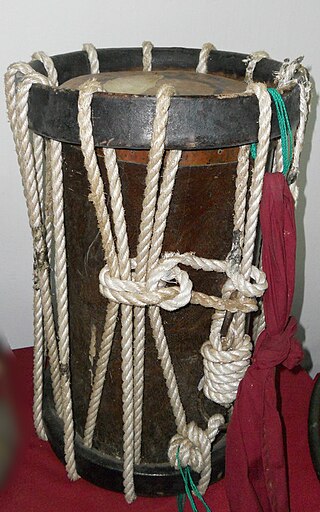
The Chenda is a cylindrical percussion instrument originating in the state of Kerala and widely used in Tulu Nadu of Karnataka and Tamil Nadu in India. In Tulu Nadu, it is known as chende. It is greatly identified as a cultural element in Kerala and Tulu Nadu.
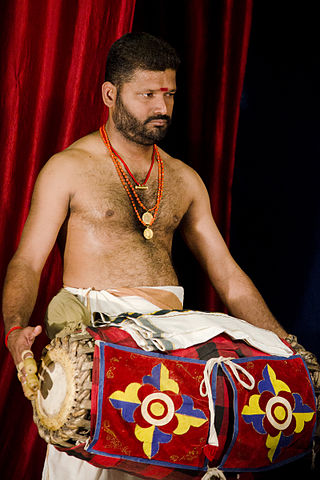
The maddalam or madhalam is a drum made out of the wood of the jackfruit tree. It has two sides for playing, made out of leather, and has different kind of sounds on each side. The maddalam is a heavy instrument which is hung around the waist of the person playing, and the player stands all the while to perform. The maddalam is a vital instrument in traditional Kerala percussion ensembles like Panchavadyam, Keli and Kathakali orchestra.
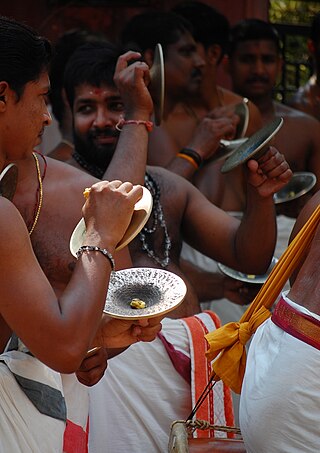
Elathalam, or Ilathalam, is a metallic musical instrument which resembles a miniature pair of cymbals. This instrument from Kerala in southern India is completely made out of bronze and has two pieces in it.
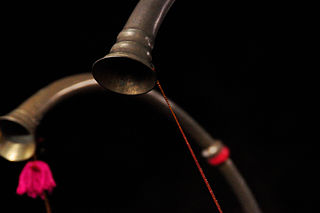
The Kombu or Kompu also known as the Kombu Pattu is a wind instrument in Tamil nadu and Kerala. Usually played along with Panchavadyam, Pandi Melam, Panchari melam etc. This musical instrument is usually seen in south India. The instrument is like a long horn.

Cherpu is a suburb of Thrissur city in the Kerala State of South India. It is 12 kilometres south of Thrissur town and is on the Thriprayar road. It is dotted by a number of temples and has quite a few rivers flowing by its vicinity.
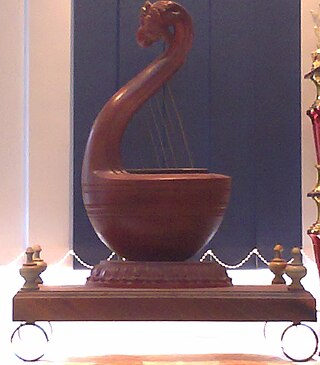
The ancient Tamil music is the historical predecessor of the Carnatic music during the Sangam period spanning from 500 BCE to 200 CE.
In Carnatic music, Maddala Keli or Maddalapattu is a musical genre featuring a set of maddalam drums as the main instrument – not chenda drums – with support from a row of ilathalam. A Maddala Keli work with five maddalam players is called Panchamaddalakeli; with ten players, Dashamaddalakeli. It sticks mainly to an eight-beat rhythmic cycle called Chembada or adi talam. It also has a segment called Kooru, where rhythmic cycles can be the six-beat panchari (pancharikkooru), the 14-beat adantha (adantha-kkooru) and the ten-beat chamba (chambakkooru). Scholars say the ensemble of thayambaka was developed from maddala keli.

The urumi is a double-headed hourglass drum from the state of Tamil Nadu, South India. Two skin heads are attached to a single hollow, often intricately carved wooden shell. The preferred wood is jackwood, although other woods like rosewood may be used. Both left and right heads are usually made from cow hide that is stretched around a thin metal ring. The outer circumference of each head is perforated with approximately seven to eight holes. The two heads are held in tension by a continuous rope that is woven around the drum in a V-shape pattern. Additional small coils of string or metal are tied around each pair of ropes near the left head. These coils can be slide horizontally along the length of the drum, increasing or decreasing the tension between the heads as necessary. For example, during the monsoon season the drum heads will slacken so much that the instrument becomes unplayable. Using these coils drummers can easily rectify such problems.

Peruvanam Pooram is one of the most popular temple festivals of the South Indian state of Kerala. It is held at Peruvanam Temple in Cherpu, Thrissur District. Lord Shiva is the presiding deity of this temple.

Parai also known as Thappattai or Thappu is a traditional percussion instrument from South India. It is a traditional instrument used to make announcements and played during festivals, folk dances, weddings and functions. The instrument in played predominantly by Tamil people in Tamil Nadu and other regions with significant Tamil diaspora such as Sri Lanka. There are many variants of the instrument, but generally consists of a drum made of wood, open on one side and closed with a stretched animal hide on the other side along with two wooden sticks used for beating the drum.

ParishaVadyam is a genre of percussion music that originated before centuries in Ramamangalam, when Panchavadyam was not there in the mainstream. Or in other words we can call Parisha Vaadyam "The Mother of Panchavadyam". Like Panchavadyam and all other Melams, Parishavaadyam also characterised by a pyramid like rhythmical structure.

Ilanjithara Melam is an assembly of percussion performance artists held at Ilanji tree at the courtyard of the Vadakkunnathan Temple in Thrissur city during the Thrissur Pooram. It is considered one of the best platforms for traditional Kerala music and the largest assembly of percussion artistes in any other Poorams. The Melam in technical exactness and instrumental discipline are the best example of Pandi Melam.

Sadanam Divakara Marar was an Indian percussionist, known for his scholarship on sopana sangeetham, marappani, parisha vadhyam and thimila paani and his mastery over various temple and ritual percussion instruments of traditional Kerala music.

Tharai or Thaarai is a wind instrument from South India. It is a traditional instrument played during festivals, folk dances, weddings and functions. The instrument in played predominantly in Tamil Nadu and in some parts of Kerala. There are many variants of the instrument, including longer and shorter versions, curved or straight and the outer pipe may be made of metal or wood. The instrument might be played along with Thappattai, a percussion instrument in folk dances and festivities or accompanied by traditional Thavil and Nadaswaram in rituals and functions.
Mazhamaṅgalaṃ Nārāyaṇan Naṃpūtiri was an Indian scholar, poet, astrologer and mathematician belonging to the Kerala school of astronomy and mathematics. Nārāyaṇan Naṃpūtiri hailed from Peruvanam village in present-day Thrissur district in Kerala. His father was Mazhamaṅgalaṃ Śaṅkaran Naṃpūtiri himself a respected scholar and writer who had authored a large number of books on astronomy and astrology in the vernacular Malayalam language in an effort to popularize astronomy among the lay public.
References
- ↑ மேள வாத்தியம். YouTube . Archived from the original on 11 December 2021.
- ↑ "Diplamo Course - d05132".
- ↑ "Archived copy". Archived from the original on 5 March 2016. Retrieved 2 April 2015.
{{cite web}}: CS1 maint: archived copy as title (link) - ↑ Archived at Ghostarchive and the Wayback Machine : நையாண்டி மேளம் - Eegarai.net. YouTube .
- ↑ "Funny Beats and Traditional Dance of Arts-Tamil Ilakkiyam,Modern Tamil Literature,Tamil Article on Tamil News and Tamil Entertainment Website". Archived from the original on 2 April 2015. Retrieved 20 November 2013.
- ↑ "மேள வாத்தியங்கள் முழங்க தமிழரசுக் கட்சியின் 14 ஆவது தேசிய மாநாடு ஆரம்பம்!". Archived from the original on 5 March 2016. Retrieved 20 November 2013.
- ↑ "Mathalam - Ancient music instruments mentioned in thirumurai - மத்தளம் - திருமுறை காட்டும் இசைக்கருவிகள்". www.shaivam.org. Archived from the original on 19 January 2013.
- ↑ "11th tirumuRai pAsurams (in tamil script, Unicode format)".
- ↑ "திருஞானசம்பந்தரின் தனிச்சிறப்புப் பதிகங்கள்".
- ↑ "Home".